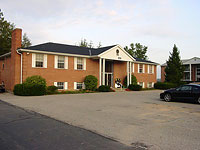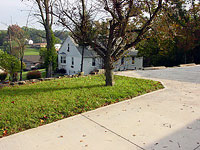Short-Tailed Shrews (Blarina brevicauda) Exhibit Unusual Behavior in an Urban Environment
by Virgil Brack Jr.
Indiana State University, Department of Ecology and Organismal Biology, Terre Haute, IN 47089
Abstract
Ecological studies typically stress the use of habitats by wildlife in natural environments. However, in urban environments, habitat use may be altered, or it may be easier to discern use or behaviors overlooked in more natural settings. This note details unique observations of the northern short-tailed shrew (Blarina brevicauda) congregating around a bird feeder, living in a flower bed isolated within a parking lot, entering buildings, eating hamburger, and using an arboreal nest in suburban Cincinnati, Ohio.
Key words: arboreal nest; barriers to movement; Blarina brevicauda; Cincinnati; foods; habitats; scavenging; short-tailed shrew
Introduction
As our world becomes increasingly developed, many species of wildlife adapt in unpredictable ways. For example, the white-tailed deer (Odocoileus virginianus), once extirpated from vast areas of the eastern U.S. but now overpopulated there, plagues many cities and suburban areas, and the peregrine falcon (Falco peregrinus), once considered endangered by the U.S. Fish and Wildlife Service, has been delisted in part because of the success of campaigns to reintroduce the species in urban environments.
Blarina brevicauda, the northern short-tailed shrew, has a broad distribution that covers the northeastern United States, including all of Ohio, and it uses a variety of habitats (Whitaker & Hamilton, 1998). Most shrews are not readily found in heavily developed areas, but B. brevicauda may be an exception. The following are observations regarding unique foods, unique habitats, and unique behaviors of shrews in two suburban areas of a major metropolitan region.
Study Area
Observations were made at two locations on the west side of Cincinnati, in Hamilton County, Ohio. The first was a residence on a busy street (2348 Neeb Road), and observations were made during the period 1989–2003. The house had been built in 1971 and was similar to many other residences in the area. It was sited on a 0.13-hectare plot with houses on both sides, and the grounds were maintained in a manner typical of a residential development. During winters, three relatively intensively used bird feeders were maintained at the back of the residence.
The second location was an office building about 2.9 kilometers south of the residence, at 781 Neeb Road. It was in an area of mixed use that included residences, apartments, a diverse array of businesses (such as office buildings and filling stations), and a combination church and school. Initial development of this area had likely occurred roughly 200 years earlier (a roadhouse and tavern once stood on the site), but the most intensive urbanization likely occurred in the mid-1900s. Nearby, redevelopment and in-filling has occurred on a regular basis, so the area is a mix of old and newer developments. At the office-building location, observations were made during the period 2000–2005.
Eating Unique Foods
Most shrews, including Blarina brevicauda, feed primarily on invertebrates found in the soil where they burrow (Whitaker & Hamilton, 1998). At the residence, I found the area below the winter bird feeders riddled with burrows of B. brevicauda. The shrews may have been drawn to invertebrates attracted by waste bird food and droppings, or directly to waste bird food. The bird feeders were filled mainly with sunflower and thistle seed, but they also contained small quantities of corn and millet. Although B. brevicauda is considered carnivorous (George, Choate & Genoways, 1986), Eadie (1944) indicated that seeds were regularly included in the diet; caches of corn have been found in burrows of wild individuals (Whitaker & Hamilton, 1998); and Martinsen (1969) documented a captive individual surviving on cracked corn. Blarina brevicauda also consumes subterranean fungi (Whitaker, 1962), which may be abundant below bird feeders. Carter (1936) provided observations of a shrew active at a suet bird feeder. There is also evidence that B. brevicauda eats vertebrates such as small mammals, salamanders, snakes, small birds—and even small hares (George et al., 1986).
On two occasions during different winters when hamburger was temporarily stored in a garage near an outside door at 2348 Neeb Road, Blarina brevicauda entered the garage via a crack under the door, burrowed through the cellophane wrapper, and ate portions of the meat. On both occasions and on several others, I saw the shrew in the garage. Shull (1907) indicated that captive short-tailed shrews ate beef, even in preference to some types of natural food, such as snails, that require time and effort to process. Eadie (1944) found feathers in scat, which he attributed to scavenging of carrion, and he suggested B. brevicauda fed on dead vole (Microtus) species. In addition, researchers bait traps and maintain individuals in traps or in the lab with dog or cat food. Consumption of many types of meat suggests short-tailed shrews may scavenge more than is generally believed. Although recent studies have not identified shrews as scavengers (DeVault & Rhodes, 2002; DeVault, Rhodes & Shivik, 2003; DeVault, Brisbin & Rhodes, 2004), the methods used to detect use of carrion organisms have depended upon carrion removal, which would not occur when a small shrew was feeding on a large carrion item. Moreover, scavenging by shrews on larger animals would leave little evidence in scats, because indigestible items such as fur need not be consumed. Even when shrews feed on small mammals, hide, appendages, and bones frequently are not consumed (Eadie, 1944; Shull, 1907).
Living in an Office Parking Lot
Areas of unsuitable habitat are not often traversed by many species of small mammals. Schreiber and Graves (1977) indicated that power-line corridors may be barriers to dispersal by Blarina brevicauda; but Yahner (1983) found that B. brevicauda moved between shelterbelts in southern Minnesota more often than four other species of small mammals studied (one other shrew and three rodents). At the office building on the west side of Cincinnati, B. brevicauda resided in a flower bed used for growing vegetables. The flower bed was surrounded on three sides by an asphalt parking lot and abutted the building on the fourth side (Figure 1). A busy street ran in front of the parking lot, and a less-used street ran beside the lot and building. There were residential and commercial lawns behind the office building and across the two adjacent streets. On one occasion, a shrew was caught in and removed from the office building. The shrew had to have climbed at least three steps to enter the building.
Miller and Getz (1977) indicated that Blarina brevicauda has broad habitat requirements but is most common in areas with greater than 50% herbaceous cover, and Getz (1961) indicated that the shrew avoids areas with little cover. The flower bed had far less than 50% vegetative cover throughout much of the growing season, and during late autumn through early spring it generally had no cover. However, the flower bed did have a layer of mulch, which may have been used in a manner similar to the way shrews use leaf litter to make shallow runways.
Nesting in a Tree
Blarina brevicauda is semifossorial, burrowing through forest litter and loose damp soil (George et al., 1986). In early October 2003, I found a B. brevicauda in a tree in the front yard of the urban residence. The tree was an ornamental crabapple (Malus species) in the lawn next to a driveway, 15 meters from a busy paved road (Figure 2). The tree forked 1 meter above ground and at that point was 20 centimeters in diameter. Typical of pruned ornamental lawn trees, it had numerous crotches and prolific branching. While trimming branches about 4 meters above ground level, I noted a nest (a ball of fine grass about 10 centimeters in diameter) in a three-way crotch at the site of previous pruning. When the branch was cut and thrown to the pavement, a shrew was crushed and killed. I did not see the shrew while cutting the limb and suspect it was in the nest.
A variety of small mammals, mostly rodents, make nests in trees, but I found only one reference of Blarina brevicauda in a tree, raiding suet at a bird feeder (Carter, 1936), and no references regarding use of arboreal nests. Underground nests of B. brevicauda are described as hollow balls 12 to 15 centimeters in diameter and made of grass, sedges, leaves, and even the fur of meadow voles, Microtus pennsylvanicus (Eadie, 1944; Hamilton, 1929; Rapp & Rapp, 1945; Shull, 1907). The nest I found in the tree closely resembled those descriptions.
Studies of wildlife most often emphasize natural aspects of the habitat, even when anthropogenic effects dominate the landscape. It is apparent from observations provided here that the short-tailed shrew readily uses an urban/suburban environment—a phenomenon we have had indirect evidence for since the 1980s from diet reports of American kestrels (Falco sparverius) feeding in an urban environment (Brack, Cable & Driscol, 1984). Careful observations of wildlife in anthropogenic landscapes may lead to the documentation of behaviors that are infrequent or overlooked in more natural settings. In addition, as suburbia becomes an increasingly dominant landscape form, the need to understand why some species can tolerate these conditions while others cannot becomes increasingly important to wildlife managers and conservation planners.
Acknowledgments
D. Sparks, D. Linzey, and T. DeVault improved the manuscript with their reviews; Environmental Solutions & Innovations, Inc. funded its development.


